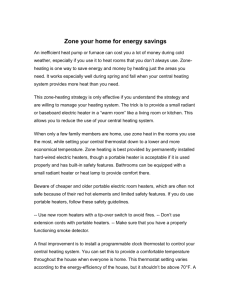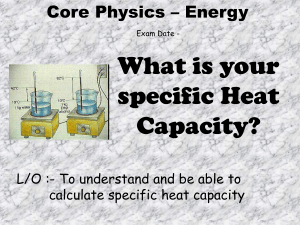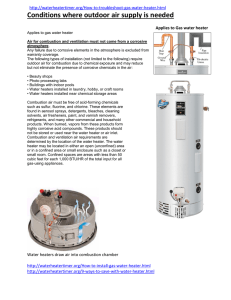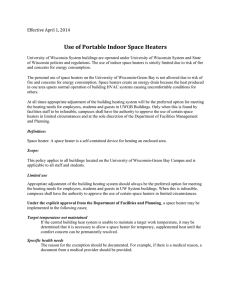Space Heater Guide - Silicon Valley Power
advertisement
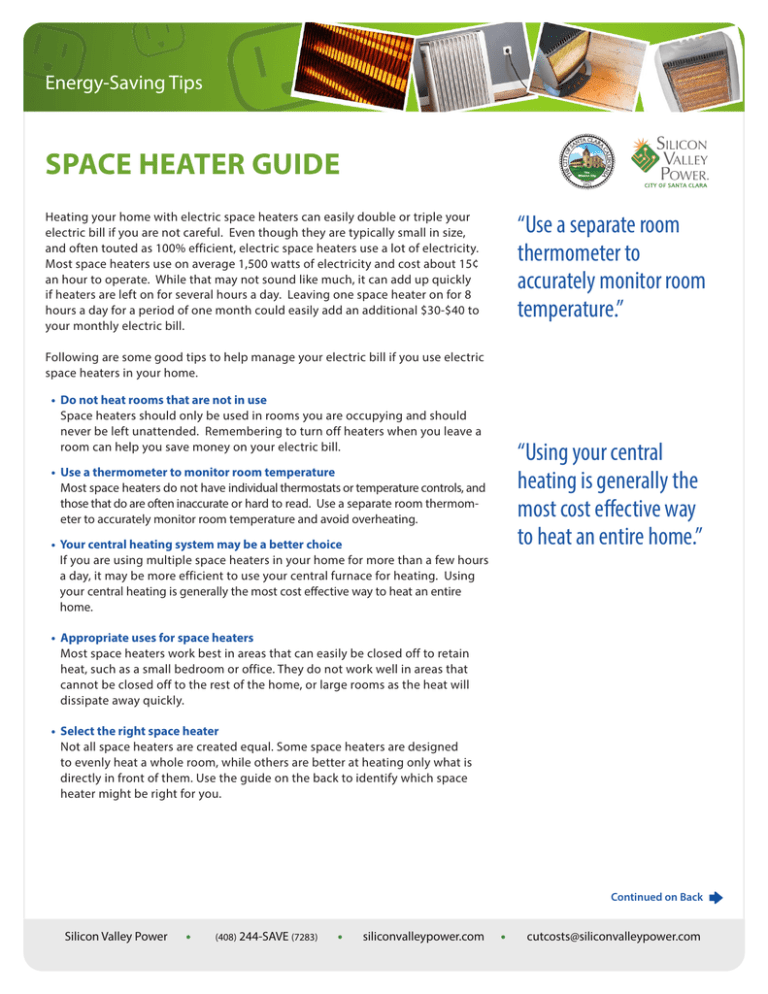
Energy-Saving Tips SPACE HEATER GUIDE Heating your home with electric space heaters can easily double or triple your electric bill if you are not careful. Even though they are typically small in size, and often touted as 100% efficient, electric space heaters use a lot of electricity. Most space heaters use on average 1,500 watts of electricity and cost about 15¢ an hour to operate. While that may not sound like much, it can add up quickly if heaters are left on for several hours a day. Leaving one space heater on for 8 hours a day for a period of one month could easily add an additional $30-$40 to your monthly electric bill. “Use a separate room thermometer to accurately monitor room temperature.” Following are some good tips to help manage your electric bill if you use electric space heaters in your home. • D o not heat rooms that are not in use Space heaters should only be used in rooms you are occupying and should never be left unattended. Remembering to turn off heaters when you leave a room can help you save money on your electric bill. • U se a thermometer to monitor room temperature Most space heaters do not have individual thermostats or temperature controls, and those that do are often inaccurate or hard to read. Use a separate room thermometer to accurately monitor room temperature and avoid overheating. •Y our central heating system may be a better choice If you are using multiple space heaters in your home for more than a few hours a day, it may be more efficient to use your central furnace for heating. Using your central heating is generally the most cost effective way to heat an entire home. “Using your central heating is generally the most cost effective way to heat an entire home.” • A ppropriate uses for space heaters Most space heaters work best in areas that can easily be closed off to retain heat, such as a small bedroom or office. They do not work well in areas that cannot be closed off to the rest of the home, or large rooms as the heat will dissipate away quickly. • S elect the right space heater Not all space heaters are created equal. Some space heaters are designed to evenly heat a whole room, while others are better at heating only what is directly in front of them. Use the guide on the back to identify which space heater might be right for you. Continued on Back Silicon Valley Power (408) 244-SAVE (7283) siliconvalleypower.com cutcosts@siliconvalleypower.com TYPES OF SPACE HEATERS BASEBOARD HEATERS Electric Usage. 250 Watts per 1 foot of heater (an average 6 foot heater uses 1.5 kWh or 15¢ for each hour of use) Cost to Purchase. Usually comes with apartment or home. Plug-in versions are available and range in price from $60 - $250. Description. Cold air is drawn through the bottom of the unit. The air is heated by electric coils and then vented through the top of the unit. RADIANT HEATERS - PARABOLIC ELECTRIC HEATER Electric Usage. Average 1,500 Watts (an average heater uses 1.5 kWh or 15¢ for each hour of use) Cost to Purchase. $40 - $100 Description. Electricity is used to heat a heating element. The heat from that element is then reflected toward a specific area. CERAMIC HEATER Electric Usage. Average 1,500 Watts (an average heater uses 1.5 kWh or 15¢ for each hour of use) Cost to Purchase. $30 - $70 Description. Ceramic plates heat up when electricity is passed through them. Aluminum baffles absorb the heat which is then dispersed by a fan. CONVECTION HEATERS - OIL FILLED HEATER Electric Usage. Average 1,500 Watts (an average heater uses 1.5 kWh or 15¢ for each hour of use) Cost to Purchase. $50 - $120 Pros. •Heats only one room as opposed to a central furnace, which heats the whole house. Cons. •Not very effective, as heat is not typically well circulated in the room. •Most units are permanently mounted to the wall so they are not mobile. Pros. •Good for heating one or two people sitting on a sofa or in a specific area. Does not heat the whole room. Cons. • Directional and does not push the heat via a fan. •Very hot and can pose fire safety risk. Pros. •Many come with built-in safety features, such as a timer, touch sensor, overheat sensor, and a thermostat. •Many have an oscillating function which allows the heat to be dispersed across a room. Cons. •Once heater is turned off, there is minimal residual heat to continue heating the room. •The fan produces some noise, unlike most of the other space heater options. Pros. •More effective at evenly heating an entire room. •Once the heater is turned off, residual heat from the oil continues to heat the space for some period of time. Description. An oil-filled heater contains oil that is stored inside a sealed compartment. The oil is heated and circulates throughthe heater. The heat comes from both sides of the heater and uses convection to heat a room. Cons. •Does not provide immediate heat. TRADITIONAL ELECTRIC HEATER Pros. •Some fans can utilize the“fan only”option, which allows the unit to be used as a fan in the summer months. •Good for heating a small, closed space. Cons. •Heats immediate area in front of the space heater. •Once the heater is turned off, there is minimal residual heat to continue heating the room. •Can pose a fire hazard, as some older models do not have an automatic shut-off. Electric Usage. Average 1,500 Watts (an average heater uses 1.5 kWh or 15¢ for each hour of use) Cost to Purchase. $20 - $60 Description. Uses electricity to heat up the heating element and a fan component to disperse the heated air. Silicon Valley Power (408) 244-SAVE (7283) siliconvalleypower.com cutcosts@siliconvalleypower.com
